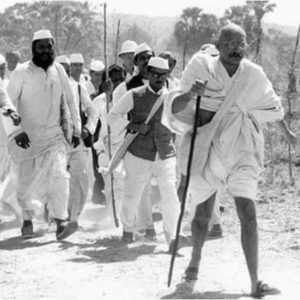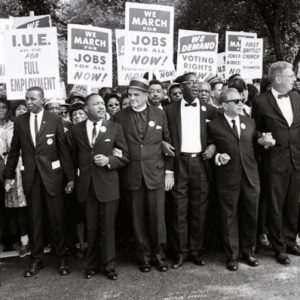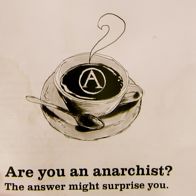-
The aim of cultivating a deep coherence between the inner workings of social purpose organizations and their outer work in the world is of course not new. Activists like Gandhi, Martin Luther King Jr., and many indigenous, feminist, anarchist, and peace activist traditions around the world have been experimenting with this approach for years. We’ve highlighted a few of them below:
 Mahatma Gandhi – The Indian Independence Movement
Mahatma Gandhi – The Indian Independence MovementYou might be surprised to hear that there is no record of Gandhi uttering the popular phrase “be the change you want to see in the world”. It was his grandson Arun Gandhi, now a journalist based in Washington, D.C., who coined the phrase after remembering Gandhi saying something like that to him when he was a young boy. Also surprising is that in all Gandhi’s writing and speeches, he rarely referred to or elaborated on his philosophy of blending the means and ends in social change work. The few reflections we did come across are quite beautiful in their directness and simplicity:
“The means may be likened to a seed, the end to a tree; and there is just the same inviolable connection between the means and the end as there is between the seed and the tree.” (Source: Hind Swaraj, [1962], p. 71)
“They say ‘means are after all means’. I would say ‘means are after all everything’. As the means so the end…There is no wall of separation between means and end. Indeed the Creator has given us control (and that too very limited) over means, none over the end. Realization of the goal is in exact proportion to that of the means. This is a proposition that admits of no exception. (Source: Young India, 17-7-’24, p. 236)
“The clearest possible definition of the goal and its appreciation would fail to take us there, if we do not know and utilize the means of achieving it. I have, therefore, concerned myself principally with the conservation of the means and their progressive use. I know if we can take care of them, attainment of the goal is assured…This method may appear to be long, perhaps too long, but I’m convinced that it is the shortest. (Source: Selections from Gandhi, [1957], pp. 36-37)
Without pouring his energy into verbally articulating why it is important to be the change you want to create, Gandhi was able to influence many people to think in this way. He embodied the concept through his activism and way of life, not always perfectly or consistently, but with an enduring commitment.
.
 Martin Luther King Jr. and The New Left – The U.S. Civil Rights Movement
Martin Luther King Jr. and The New Left – The U.S. Civil Rights Movement“In the early days of the US civil rights movement, Martin Luther King Jr. used the phrase ‘Beloved Community’ to describe the kind of change he was working towards. The Beloved Community expressed a way of organising that made non-violence and compassion both its means and its ends, and placed strong relationships at the core of wider social transformation. The phrase, initially coined by philosopher-theologian Josiah Royce, articulated the idea that organising based on Love will create a culture of Love in its wake. King said:
“Love is creative and redemptive. Love builds up and unites; hate tears down and destroys. The aftermath of the ‘fight with fire’ method… is bitterness and chaos, the aftermath of the love method is reconciliation and creation of the beloved community. Physical force can repress, restrain, coerce, destroy, but it cannot create and organize anything permanent; only love can do that.”
The King Centre describes the Beloved Community as ‘an overall effort to achieve a reconciled world by raising the level of relationships among people to a height where justice prevails and persons attain their full human potential.’”
(Source: Excerpted from ‘Structuring our beloved communities?’ by Liam Barrington-Bush)
“Coined by political theorist Carl Boggs and popularized by sociologist Wini Breines, the term ‘prefigurative politics’ emerged out of analysis of New Left movements in the United States. Rejecting both the Leninist cadre organization of the Old Left and conventional political parties, members of the New Left attempted to create activist communities that embodied the concept of participatory democracy, an idea famously championed in the 1962 Port Huron Statement of the Students for a Democratic Society, or SDS. In a 1980 essay, Breines argues that the central imperative of prefigurative politics was to “create and sustain within the live practice of the movement, relationships and political forms that ‘prefigured’ and embodied the desired society.” Instead of waiting for revolution in the future, the New Left sought to experience it in the present through the movements it created.
…As an example, within the Student Nonviolent Coordinating Committee, or SNCC, participants spoke of the desire to create the “beloved community” — a society that rejected bigotry and prejudice in all forms and instead embraced peace and brotherliness. This new world would be based on an “understanding, redeeming goodwill for all,” as Martin Luther King (an allied promoter of the concept) described it.
This was not merely an external goal; rather, SNCC militants saw themselves as creating the beloved community within their organization — an interracial group which, in the words of one historian, “based itself on radical egalitarianism, mutual respect and unconditional support for every person’s unique gifts and contributions. Meetings lasted until everyone had their say, in the belief that every voice counted.” The strong ties fostered by this prefigurative community encouraged participants to undertake bold and dangerous acts of civil disobedience — such as SNCC’s famous sit-ins at lunch counters in the segregated South. In this case, the aspiration to a beloved community both facilitated strategic action and had a significant impact on mainstream politics.”
(Source: Excerpted from ‘Should we fight the system or be the change?’ by Mark Engler and Paul Engler)
 The Anarchist Tradition
The Anarchist TraditionAnarchists seem to approach ‘organization’ as a verb not a noun. Their concern is that when we formalize our collaborative exchanges into what we call an organization, our social environment becomes increasingly calcified and thus less responsive to our ever-evolving needs as humans. And because organizations, by their very nature, are either working from the past or planning for the future, they greatly hamper our capacity to live fully in the moment. So in essence, the anarchist stance is that the best way for us to live out our vision for a just world is to unshackle ourselves as much as possible from the organizational contraptions we have created and to focus on the relationships in the here and now:
Anarchists use democracy- but we don’t let democracy use us. For us, the first and last matter is always the needs and feelings of the individuals involved- any system to address them is provisional at best. We don’t try to force ourselves into the confines of any established procedures- we apply procedures to the extent that they serve human needs, and discard them past that point. …We don’t prize consensus, let alone The Rule of Law, above our own values and dreams…we see [them] as nothing more than the shadows of our predecessors’ customs, lengthened by the years to seem more wise than our own judgement. Seriously, what should come first- our systems, or us? (Fighting for our lives: An anarchist primer, CrimethInc.)
What’s good for others is good for us, since our relationships with them make up the world in which we live; but serving their needs at our own expense would cheat them of our potential as free and happy companions, which is perhaps the best gift we can offer. Our vision of healthy relationships rests on the notion that self versus other, selfish versus selfless, is a false dichotomy, like all dichotomies. Those who preach self-sacrifice for the greater good are still working from the competitive model of individual-versus-society, as are those who would aspire to an individualist independence; for us, individuals and communities alike are both convergences of threads in the great web of existence, inseparable from one another, corresponding to one another. The freedom and self-determination we cherish are only possible in the context of the culture we create together; yet in order to contribute to that creation, we must create ourselves individually. That is: if you can save yourself, you could save the world, but you must save the world to save yourself.
(Source: Fighting for our lives: An anarchist primer, CrimethInc.)
.
Do you know of any other activists, organizations, movements (past of present) that encourage an embodied approach to social change? If so, share them in the Facebook comment section. And if you have any quotes, book passages, videos clips, to accompany your reference please share them as well.
.
TOOC learning nugget: Looking back in time and across the globe



